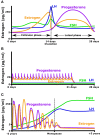Effect of Estrogen on Musculoskeletal Performance and Injury Risk
- PMID: 30697162
- PMCID: PMC6341375
- DOI: 10.3389/fphys.2018.01834
Effect of Estrogen on Musculoskeletal Performance and Injury Risk
Abstract
Estrogen has a dramatic effect on musculoskeletal function. Beyond the known relationship between estrogen and bone, it directly affects the structure and function of other musculoskeletal tissues such as muscle, tendon, and ligament. In these other musculoskeletal tissues, estrogen improves muscle mass and strength, and increases the collagen content of connective tissues. However, unlike bone and muscle where estrogen improves function, in tendons and ligaments estrogen decreases stiffness, and this directly affects performance and injury rates. High estrogen levels can decrease power and performance and make women more prone for catastrophic ligament injury. The goal of the current work is to review the research that forms the basis of our understanding how estrogen affects muscle, tendon, and ligament and how hormonal manipulation can be used to optimize performance and promote female participation in an active lifestyle at any age.
Keywords: ACL; estrogen; exercise; injury risk; ligament; muscle; tendon.
Figures




Similar articles
-
Estrogen inhibits lysyl oxidase and decreases mechanical function in engineered ligaments.J Appl Physiol (1985). 2015 May 15;118(10):1250-7. doi: 10.1152/japplphysiol.00823.2014. Epub 2015 Apr 2. J Appl Physiol (1985). 2015. PMID: 25979936
-
Effects of orally administered hormonal contraceptives on the musculoskeletal system of healthy premenopausal women-A systematic review.Health Sci Rep. 2022 Aug 10;5(5):e776. doi: 10.1002/hsr2.776. eCollection 2022 Sep. Health Sci Rep. 2022. PMID: 35957969 Free PMC article. Review.
-
The effect of estrogen on tendon and ligament metabolism and function.J Steroid Biochem Mol Biol. 2017 Sep;172:106-116. doi: 10.1016/j.jsbmb.2017.06.008. Epub 2017 Jun 16. J Steroid Biochem Mol Biol. 2017. PMID: 28629994 Review.
-
Minimizing Injury and Maximizing Return to Play: Lessons from Engineered Ligaments.Sports Med. 2017 Mar;47(Suppl 1):5-11. doi: 10.1007/s40279-017-0719-x. Sports Med. 2017. PMID: 28332110 Free PMC article. Review.
-
Sex Hormones and Tendon.Adv Exp Med Biol. 2016;920:139-49. doi: 10.1007/978-3-319-33943-6_13. Adv Exp Med Biol. 2016. PMID: 27535256 Review.
Cited by
-
Unilateral hand force control impairments in older women.EXCLI J. 2022 Sep 22;21:1231-1244. doi: 10.17179/excli2022-5362. eCollection 2022. EXCLI J. 2022. PMID: 36381646 Free PMC article.
-
In-Season Microcycle Quantification of Professional Women Soccer Players-External, Internal and Wellness Measures.Healthcare (Basel). 2022 Apr 7;10(4):695. doi: 10.3390/healthcare10040695. Healthcare (Basel). 2022. PMID: 35455872 Free PMC article.
-
Musculoskeletal Morphology and Joint Flexibility-Associated Functional Characteristics across Three Time Points during the Menstrual Cycle in Female Contemporary Dancers.J Funct Morphol Kinesiol. 2024 Feb 25;9(1):38. doi: 10.3390/jfmk9010038. J Funct Morphol Kinesiol. 2024. PMID: 38535418 Free PMC article.
-
Original salivary sex hormone data of naturally menstruating athletes and hormonal contraceptive users.BMJ Open Sport Exerc Med. 2024 Nov 13;10(4):e002078. doi: 10.1136/bmjsem-2024-002078. eCollection 2024. BMJ Open Sport Exerc Med. 2024. PMID: 39564535 Free PMC article.
-
Low back pain trends attributable to high body mass index over the period 1990-2021 and projections up to 2036.Front Nutr. 2025 Jan 21;11:1521567. doi: 10.3389/fnut.2024.1521567. eCollection 2024. Front Nutr. 2025. PMID: 39906897 Free PMC article.
References
Publication types
Grants and funding
LinkOut - more resources
Full Text Sources
Other Literature Sources
Medical

